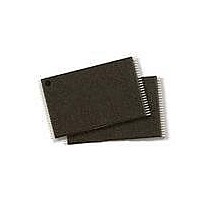S29JL032H70TFI420 Spansion Inc., S29JL032H70TFI420 Datasheet - Page 39

S29JL032H70TFI420
Manufacturer Part Number
S29JL032H70TFI420
Description
IC,EEPROM,NOR FLASH,2MX16/4MX8,CMOS,TSSOP,48PIN,PLASTIC
Manufacturer
Spansion Inc.
Datasheets
1.S29JL032H70TFI420.pdf
(60 pages)
2.S29JL032H70TFI020.pdf
(64 pages)
3.S29JL032H70TFI420.pdf
(66 pages)
Specifications of S29JL032H70TFI420
Data Bus Width
8 bit, 16 bit
Architecture
Boot Sector
Interface Type
Conventional
Access Time
70 ns
Supply Voltage (max)
3.6 V
Supply Voltage (min)
2.7 V
Maximum Operating Current
2 mA
Mounting Style
SMD/SMT
Memory Type
Flash
Memory Size
32 Mbit
Operating Temperature
+ 85 C
Package / Case
TSOP-48
Lead Free Status / RoHS Status
Lead free / RoHS Compliant
Lead Free Status / RoHS Status
Lead free / RoHS Compliant
Available stocks
Company
Part Number
Manufacturer
Quantity
Price
Company:
Part Number:
S29JL032H70TFI420
Manufacturer:
Spansion
Quantity:
2 356
Write Operation Status
May 21, 2004 S29JL032HA0
DQ7: Data# Polling
The device provides several bits to determine the status of a program or erase
operation: DQ2, DQ3, DQ5, DQ6, and DQ7. Table
tions describe the function of these bits. DQ7 and DQ6 each offer a method for
determining whether a program or erase operation is complete or in progress.
The device also provides a hardware-based output signal, RY/BY#, to determine
whether an Embedded Program or Erase operation is in progress or has been
completed.
The Data# Polling bit, DQ7, indicates to the host system whether an Embedded
Program or Erase algorithm is in progress or completed, or whether a bank is in
Erase Suspend. Data# Polling is valid after the rising edge of the final WE# pulse
in the command sequence.
During the Embedded Program algorithm, the device outputs on DQ7 the com-
plement of the datum programmed to DQ7. This DQ7 status also applies to
programming during Erase Suspend. When the Embedded Program algorithm is
complete, the device outputs the datum programmed to DQ7. The system must
provide the program address to read valid status information on DQ7. If a pro-
gram address falls within a protected sector, Data# Polling on DQ7 is active for
approximately 1 µs, then that bank returns to the read mode.
During the Embedded Erase algorithm, Data# Polling produces a “0” on DQ7.
When the Embedded Erase algorithm is complete, or if the bank enters the Erase
Suspend mode, Data# Polling produces a “1” on DQ7. The system must provide
an address within any of the sectors selected for erasure to read valid status in-
formation on DQ7.
After an erase command sequence is written, if all sectors selected for erasing
are protected, Data# Polling on DQ7 is active for approximately 100 µs, then the
bank returns to the read mode. If not all selected sectors are protected, the Em-
bedded Erase algorithm erases the unprotected sectors, and ignores the selected
sectors that are protected. However, if the system reads DQ7 at an address within
a protected sector, the status may not be valid.
When the system detects DQ7 has changed from the complement to true data,
it can read valid data at DQ15–DQ0 (or DQ7–DQ0 for x8-only device) on the fol-
lowing read cycles. Just prior to the completion of an Embedded Program or Erase
operation, DQ7 may change asynchronously with DQ15–DQ8 (DQ7–DQ0 for x8-
only device) while Output Enable (OE#) is asserted low. That is, the device may
change from providing status information to valid data on DQ7. Depending on
when the system samples the DQ7 output, it may read the status or valid data.
Even if the device has completed the program or erase operation and DQ7 has
valid data, the data outputs on DQ15–DQ0 may be still invalid. Valid data on
DQ15–DQ0 (or DQ7–DQ0 for x8-only device) will appear on successive read
cycles.
Table
algorithm. 22 in the AC Characteristics section shows the Data# Polling timing
diagram.
14
shows the outputs for Data# Polling on DQ7. 6 shows the Data# Polling
A D V A N C E
I N F O R M A T I O N
S29JL032H
14
and the following subsec-
39
















